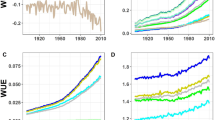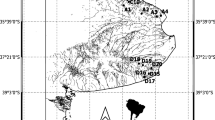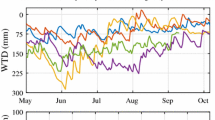Summary
The response of tussock tundra to elevated atmospheric concentrations of CO2 was measured at Toolik Lake, Alaska in the summer of 1983. Computer-controlled greenhouses were used to determine diurnal ecosystem flux of CO2 under four treatments: 340 ppm, 510 ppm, and 680 ppm CO2, as well as 680 ppm CO2 with a four degree centrigrade increase in temperature. For the seven days of data analyzed, net daily CO2 flux was significantly different between treatments. Net uptake was positively correlated with CO2 concentration in the chamber and negatively correlated with temperature. A nonlinear model was used to analyze this data set and to determine some of the reasons for different net CO2 flux. This model allowed an estimation of light utilization efficiency, total conductance of CO2, and a comparable measure of total respiration. From this analysis we conclude that nutrient limitations in the arctic decrease the capacity of tundra plants to make use of elevated CO2 concentrations. The plants respond by decreasing conductance in the presence of elevated CO2, which results in approximately equal gross uptake rates for the three CO2 treatments. Apparent changes in system respiration result in higher net uptake under elevated CO2 but this may be due to biases in the data. The treatment with increased temperature exhibited higher conductances and, consequently, higher gross uptake of CO2 than the other treatments. Higher temperatures, however, also increase respiration with the result being lower net uptake than would be expected in the absence of temperature inscreases.
Similar content being viewed by others
References
Akita S, Moss DN (1972) Differential stomatal response between C3 and C4 species to atmospheric CO2 concentrations and light. Crop Sci 12:789–793
Billings DW, Juken JD, Mortensen DA, Peterson KM (1982) Arctic tundra: a source or sink for atmospheric carbon dioxide in a changing environment. Oecologia (Berlin) 53:7–11
Bischof W (1977) Comparability of CO2 measurements. Tellus 29:435–444
Burgess A, Fenton F (1953) The effect of carbon dioxide on the growth of certain soil fungi. Trans Brit Mycol Soc 36:104–108
Carlson RW, Bazzaz FA (1980) The effects of elevated CO2 concentrations on growth, photosynthesis, transpiration, and water use efficiency of plants. In: Singh JJ, Deepak A (eds) Environmental and climatic impact of coal utilization. Academic Press, New York, pp 609–623
Charles-Edwards DA (1981) The mathematics of photosynthesis and productivity. Academic Press, London
Clough JM, Peet MM, Kramer PJ (1981) Effects of high atmospheric CO2 and sink size on rates of photosynthesis of a soybean cultivar. Plant Physiol 67:1007–1010
Coyne PI, Kelley JJ (1978) Meteorological assessment of CO2 exchange over an Alaskan arctic tundra. In: Tieszen LL (ed) Vegetation and production ecology of an alaskan arctic tundra. Springer, Heidelberg Berlin New York, pp 299–321
Egli DB, Pendleton JW, Peters DB (1970) Photosynthetic rates of three soybean communities as related to carbon dioxide levels and solar radiation. Agron J 62:411–414
Farquhar GD, Dubbe DR, Raschke K (1978) Gain of the feedback loop involving carbon dioxide and stomata. Plant Physiol 62:406–412
Farquhar GD, Sharkey TD (1982) Stomatal conductance and photosynthesis. Ann Rev Plant Physiol 33:317–345
Frydrych J (1976) Photosynthetic characteristics of cucumber seedlings grown under two levels of carbon dioxide. Photosynthetica 10:335–338
Gifford RM, Lambers H, Morrison JIL (1985) Respiration of crop species under CO2 enrichment. Physiol Plant 63:351–356
Griffin DM (1972) Ecology of soil fungi. Chapman and Hall, London
Hofstra G, Hesketh JD (1975) The effect of temperature and CO2 enrichment on photosynthesis in soybeans. In: Marcelle R (ed) Environmental and biological control of photosynthesis. Dr. W. Junk, The Hague, pp 71–80
Keeling CD, Bacastow RB, Bainbridge AE, Ekdahl CA Jr, Guenther PR, Waterman LS, Chin JFS (1976) Atmospheric carbon dioxide variations at Mauna Loa Observatory, Hawaii. Tellus 28:538–551
Limbach WE, Oechel WC, Lowell W (1982) Photosynthetic and respiratory responses to temperature and light of three Alaskan tundra growth forms. Hol Ecol 5:150–157
Lotka AJ (1924) Elements of physical biology. Williams and Wilkins, Baltimore, 460 pp
Madsen E (1973) Effect of CO2-concentration on the morphological, histological and cytological changes in tomato plants. Acta Agric Scand 23:241–246
Manabe S, Stouffer RJ (1980) Sensitivity of a global climate model to an increase of CO2 concentration in the atmosphere. J Geophys Res 85:5529–5554
Marquardt DW (1963) An algorithm for least squares estimation of nonlinear parameters. J Soc Ind Appl Math 2:431–441
Mauney JK, Fry KE, Guinn G (1978) Relationship of photosynthetic rate to growth and fruiting of cotton, soybean, sorghum and sunflower. Crop Sci 18:259–263
Miller PC (1981) Carbon balance in northern ecosystems and the potential effects of carbon dioxide-induced climatic change. Report of a workshop, San Diego CA, March 7–9 1980, US Department of Energy, Washington, DC
Miller PC, Kendall R, Oechel WC (1983) Simulating carbon accumulation in northern ecosystems. Simulation 40:119–131
Morrison IL, Gifford RW (1983) Stomatal sensitivity to carbon dioxide and humidity: a comparison of two C3 and two C4 grass species. Plant Physiol 71:789–796
Nafziger ED, Koller HR (1976) Influence of leaf starch concentration on CO2 assimilation in soybean. Plant Physiol 57:560–563
Oechel WC (1976) Seasonal patterns of temperature response of CO2 flux and acclimation in arctic mosses growing in situ. Photosynth 10:447–456
Pales JC, Keeling CD (1965) The concentration of atmospheric carbon dioxide in Hawaii. J Geophys Res 70:6053–6076
Prudhomme TI, Oechel WC, Hastings JC, Lawrence WT (1984a) Net ecosystem gas exchange at ambient and elevated carbon dioxide concentrations in tussock tundra at Toolik Lake Alaska: an evaluation of methods and initial results. In: McBeath JH (ed) The potential effects of carbon dioxide-induced climatic changes in Alaska. Univ of Alaska-Fairbanks, Misc Pub 83, pp 155–162
Prudhomme TI, Lawrence WT, Oechel WC (1984b) A field-based system for studying community level responses to elevated atmospheric carbon dioxide. Bull Ecol Soc Am 65:84
Regehr DL, Bazzaz FA, Boggess WR (1975) Photosynthesis, transpiration and leaf conductance of Populis deltoides in relation to flooding and drought. Photo 9:52–61
Strotsky G, Goos RD (1964) Effect of high CO2 and low CO2 tensions on the soil microbiota. Can J Micro 11:853–868
Stuart L, Miller PC (1982) Effect of fertilization, altered drainage and vehicle tracks on soil aeration in tussock tundra. Can J Soil Sci 62:495–502
Tieszen LL (1978) Photosynthesis in the principle Barrow, Alaska species: a summer of field and laboratory responses. In: Tieszen LL (ed) Vegetation and production ecology of an Alaskan arctic tundra. Springer, Berlin Heidelberg New York, pp 24–268
Tinus RW (1972) CO2 enriched atmosphere seeds growth of ponderosa pine and blue spruce seedlings. Tree Planters' Notes 23:12–15
Tissue DT, Oechel WC (1984) Physiological and growth responses of Eriophorum vaginatum to elevated CO2 and temperature. Bull Ecol Soc Am 65:85
Wigley TML, Jones PD, Kelly PM (1980) Scenario for a warm, high CO2 world. Nature 283:17–21
Wong SC (1979) Elevated atmospheric partial pressure of CO2 and plant growth. Oecologia (Berlin) 44:68–74
Wulff RD, Strain BR (1982) Effects of CO2 enrichment on growth and photosynthesis in Desmodium paniculatum. Can J Bot 60:1084–1091
Author information
Authors and Affiliations
Rights and permissions
About this article
Cite this article
Hilbert, D.W., Prudhomme, T.I. & Oechel, W.C. Response of tussock tundra to elevated carbon dioxide regimes: analysis of ecosystem CO2 flux through nonlinear modeling. Oecologia 72, 466–472 (1987). https://doi.org/10.1007/BF00377581
Received:
Issue Date:
DOI: https://doi.org/10.1007/BF00377581




